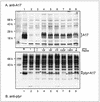Tyrosine phosphorylation of A17 during vaccinia virus infection: involvement of the H1 phosphatase and the F10 kinase
- PMID: 10438817
- PMCID: PMC104254
- DOI: 10.1128/JVI.73.9.7287-7296.1999
Tyrosine phosphorylation of A17 during vaccinia virus infection: involvement of the H1 phosphatase and the F10 kinase
Abstract
Vaccinia virus encodes two protein kinases (B1 and F10) and a dual-specificity phosphatase (VH1), suggesting that phosphorylation and dephosphorylation of substrates on serine/threonine and tyrosine residues are important in regulating diverse aspects of the viral life cycle. Using a recombinant in which expression of the H1 phosphatase can be regulated experimentally (vindH1), we have previously demonstrated that repression of H1 leads to the maturation of noninfectious virions that contain several hyperphosphorylated substrates (K. Liu et al., J. Virol. 69:7823-7834). In this report, we demonstrate that among these is a 25-kDa protein that is phosphorylated on tyrosine residues in H1-deficient virions and can be dephosphorylated by recombinant H1. We demonstrate that the 25-kDa phosphoprotein represents the product of the A17 gene and that A17 is phosphorylated on serine, threonine, and tyrosine residues during infection. Detection of phosphotyrosine within A17 is abrogated when Tyr(203) (but not Tyr(3), Tyr(6), or Tyr(7)) is mutated to phenylalanine, suggesting strongly that this amino acid is the site of tyrosine phosphorylation. Phosphorylation of A17 fails to occur during nonpermissive infections performed with temperature-sensitive mutants defective in the F10 kinase. Our data suggest that this enzyme, which was initially characterized as a serine/threonine kinase, might in fact have dual specificity. This hypothesis is strengthened by the observation that Escherichia coli induced to express F10 contain multiple proteins which are recognized by antiphosphotyrosine antiserum. This study presents the first evidence for phosphotyrosine signaling during vaccinia virus infection and implicates the F10 kinase and the H1 phosphatase as the dual-specificity enzymes that direct this cycle of reversible phosphorylation.
Figures






References
-
- Banham A H, Smith G L. Vaccinia virus gene B1R encodes a 34-kDa serine/threonine protein kinase that localizes in cytoplasmic factories and is packaged into virions. Virology. 1992;191:803–812. - PubMed
-
- Beaud G, Sharif A, Topa-Masse A, Leader D P. Ribosomal protein S2/Sa kinase purified from HeLa cells infected with vaccinia virus corresponds to the B1R protein kinase and phosphorylates in vitro the viral ssDNA-binding protein. J Gen Virol. 1994;75:283–293. - PubMed
-
- Casnellie J E. Assay of protein kinases using peptides with basic residues for phosphocellulose binding. Methods Enzymol. 1991;200:115–121. - PubMed
-
- Condit R C, Motyczka A, Spizz G. Isolation, characterization and physical mapping of temperature sensitive mutants of vaccinia virus. Virology. 1983;128:429–443. - PubMed
Publication types
MeSH terms
Substances
Grants and funding
LinkOut - more resources
Full Text Sources
Miscellaneous

